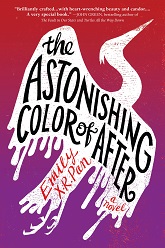On the same day Leigh Chen Sanders kissed the boy she’d pined over for years, her mother, Dory, committed suicide. She leaves no note, no reason or explanation, just a cavernous hole in the Sanders’ world. At first the grief is overwhelming. She feels trapped in her childhood home with her distant father and the bloodstain marking her mother’s demise haunting her thoughts. Then, the night before the funeral, Leigh is roused from her nightmares by a huge crimson bird calling her name. She knows immediately the bird is her mother, the whys and hows brushed aside in the face a daughter’s longing for her mom.
At the behest of the bird, Leigh and her father travel to Taiwan to meet her mother’s estranged family. Desperate to save her mother, to make contact, to be close once again, she digs through old family memories and unearths long-hidden secrets. With the guidance of the bird and a box of magical incense, Leigh is pulled between reality and fantasy until she can no longer tell the difference between them. What she learns on her journey won’t change the past, but may finally put it to rest.
Buy the Book


The Astonishing Color of After
There’s a lot going on in The Astonishing Color of After, much of it revolving around the feeling of isolation at being trapped between two states. Americans call Leigh’s half-Taiwanese and half-white background “exotic,” and in Taiwan they call her hunxie or “mixed blood.” In both lands she is othered and never feels wholly connected to either cultural group. In life, her mother lived in the liminal space that is depression, a place smothered in a deep and endless fog of nothingness with rare glimpses of light. On the occasions she clawed her way out, she was stuck between the past life she longed to forget and the present life she could never quite settle into. And in death she is trapped between her last breath and the afterlife. Leigh’s father, too, exists in between—here and there, home and on the road, a parent but not a father. Even her grandparents hover between nursing old wounds and yearning to let go.
Leigh, an artist, uses colors to describe her feelings—“The urgency and longing wrap around me in swirls of aureolin and caput mortuum violet.”—as if by choosing a color she can better understand what she’s going through. It’s her way of processing and defining. Through Leigh’s emotional, illuminating first person narration, Emily X. R. Pan peels back the layers of her grief to expose the heart at the center. The result is a novel as lyrical as it is earnest:
“I thought I would be able to sleep after tonight, but instead all I can think about is that feather, and ghosts, and other dimensions. And what’s real.
And colors.
I see colors in the dark now. Sometimes they form shapes, or even faces. Sometimes they get angry with me, turn a dirty, boiling crimson. Sometimes they try to soothe me, drawing themselves like crystals in a pale dusty blue.
I don’t even have to close my eyes. The colors are just there, floating above me, like little truth tellers. Wherever my thoughts go, they follow.”
Pan is less interested in the reality of Leigh’s experience than in the truths she comes to because of it. It doesn’t so much matter whether or not she really can see visions of the past. What matters is what she learns, what she does, what she becomes afterward. Leigh believes her mother is a bird. It’s not up to us to question the bird’s existence. All we need to do is follow Leigh down her path.
Through Leigh, Pan takes a long, difficult look at what it’s like to be left behind when someone you love dies. Thankfully she steers clear of victim-blaming or psychoanalyzing Leigh’s mother. She suffers from profound depression until she can no longer carry the weight. It happens, and it’s hard, but I think it’s important to shine a light on it. Fiction can help us deal with the unbearable and provide context for the unfathomable. Pan doesn’t shy away from the awfulness of Dory’s death. She doesn’t sugarcoat or gloss over, nor does she wallow or ogle. She offers little in the way of explanation for why Dory does what she does, but so goes life. We live in a world that rarely gives easy answers; sometimes it’s enough just to ask the question.
Out of everything, the only ineffective element of the novel for me was Leigh’s fledgling romance with Axel, her half-Puerto Rican half Filipino BFF. Her feelings for him are vast, but other than proximity and that he was nice to her, I couldn’t figure out why she was so into him. I was way more invested in Leigh sorting things out with her relations than in whether or not she was going to kiss some dude again. I don’t mean to make it out to be more flippant than it really is. Her and Axel’s constant circling of each other is central to Leigh’s maturity, so it wasn’t a superfluous subplot. It just didn’t work for me, however I fully expect my opinion to be in the minority for most readers.
The Astonishing Color of After is a gorgeous, heartbreaking read. For a debut author, what Emily X. R. Pan has achieved here is, well, astonishing. It’s a sad, beautiful book that made me smile as often as I teared up. This is a big, slow-moving novel tackling heavy issues. Pan is in no rush to get to the point. The point will come when everything has been said and done. Just let yourself go with the experience. Trust me, you won’t regret it.
The Astonishing Color of After is available from Little, Brown Young Readers.
Alex Brown is a YA librarian by day, local historian by night, pop culture critic/reviewer by passion, and QWoC all the time. Keep up with her every move on Twitter, check out her endless barrage of cute rat pics on Instagram, or get lost in the rabbit warren of ships and fandoms on Tumblr.










